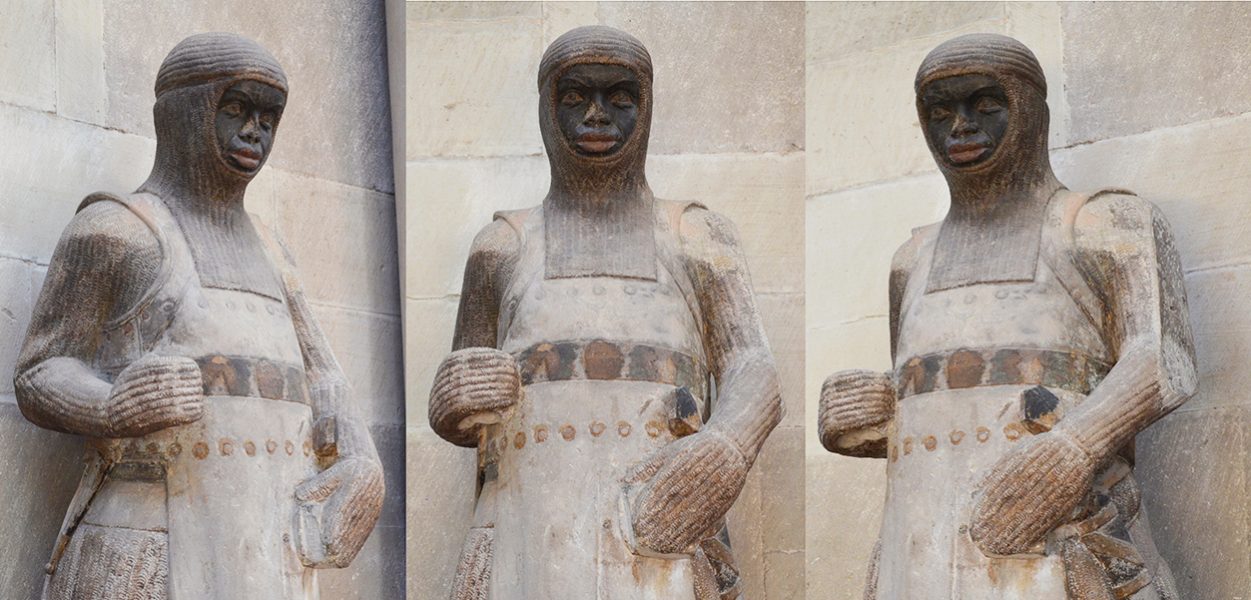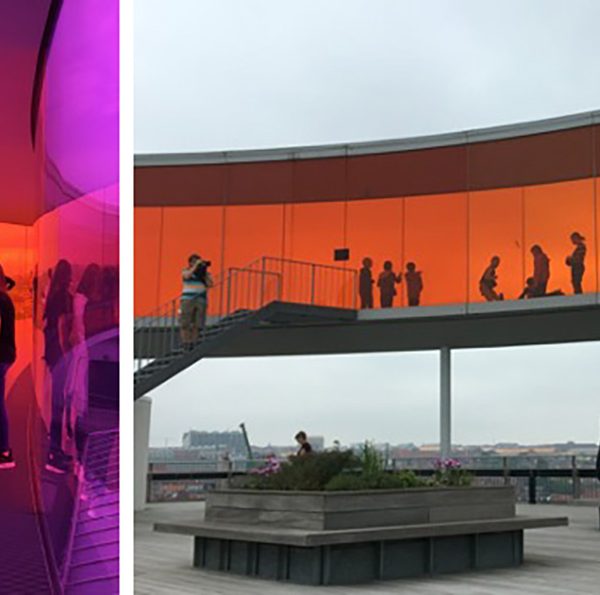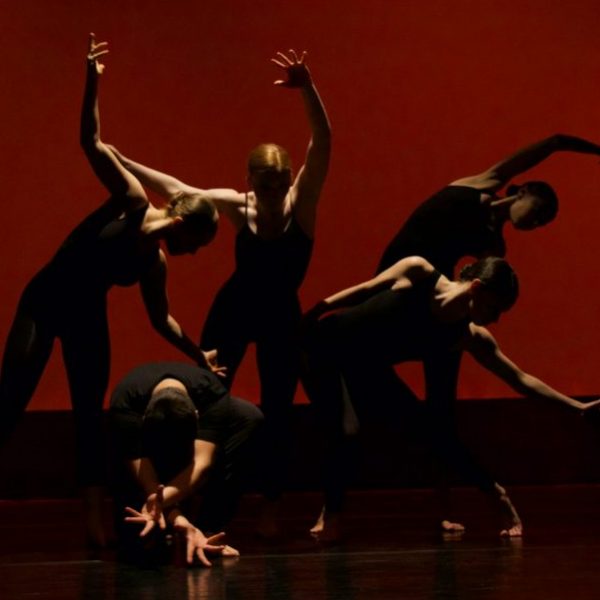Reflections on Africans in Gothic Sculpture, part 3
Erasure, Submission, Apotheosis
Jacqueline E. Jung —
Though hardly numerous, images of African men – often dressed in military garb, and always acting on behalf of established institutional powers – played vital roles in the sculptural programs of French and German Gothic cathedrals. At Magdeburg, St. Maurice was a well-armed defender of the Church, while at Chartres, Paris, and elsewhere Black soldiers and attendants carried out the demands of royal, state, or non-Christian religious authorities.
Where are the Black women? Like the Jewish women Sara Lipton has sought in medieval manuscripts, they are all but invisible. I know of just one example in Gothic sculpture, from the late fifteenth century: a Foolish Virgin, elegantly dressed in court attire, who stands at the Last Judgment portal of Bern Minster. (I discuss this ensemble in Eloquent Bodies using photos of the modern replicas now installed in situ. The pictures here show the original sculptures in the Kunstmuseum Bern.)

Some scholars suggest that her racialized physiognomy – not just her dark color but also her broad nose, full lips, and tightly curled hair – points to the patronage of the local Drapers’ Guild, known since the 1380s as the Mohrenzunft (Moors’ Guild). But in light of the real presence of African courtiers in European aristocratic circles from the late fifteenth century onward, the woman would have underscored the cosmopolitan quality of this glamorous, if ill-fated, group, and heightened the pathos of their exclusion from the heavenly wedding feast.

The broader absence of Black women from Gothic sculpture is not because they had no place in the biblical and hagiographical literature from which medieval artists so liberally borrowed. The Queen of Sheba, who journeyed to Solomon’s court bearing an abundance of spices, gold, and gems (3 Kings 10: 1-13) and whom Christians identified as the Beloved in the Song of Songs, was one especially vivid character. Medieval commentators envisioned her as traveling from the southern reaches of the earth, the lands they called Ethiopia. As such, they imagined her as dark-skinned, an assumption they found confirmed in the Song of Songs where she calls herself “black but beautiful” (negro sum sed formosam, in Jerome’s Latin translation; the original Hebrew has her as “black and beautiful”).
This posed a problem for medieval artists, for whom a long tradition of color symbolism, closely tied to theology, aligned lightness or brightness with virtue and darkness with sin, and thus made female beauty synonymous with white female beauty. In French vernacular romances, the dark complexions of Muslim princesses encountered by the Crusading heroes either rendered them monstrous (if they adhered to their faith) or disappeared upon their acceptance of Christianity. The purported malleability of Jewish women too, their willingness to convert, was precisely what made them disappear from medieval pictures; once they shed their old faith, artists suggested, they became indistinguishable from Christian women.

The goldsmith Nicholas of Verdun, in the set of enamel panels made for the monastery of Klosterneuburg in the late twelfth century, found one solution to the Queen of Sheba’s challenge: he gave her the delicate face, svelte body, and hipshot stance of a Classical goddess while using a deep blue enamel to display her black skin. Both her beauty and her blackness highlight the contrast with her two male attendants. Their faces are rendered in gold, the default skin color in this ensemble, but both are physically stout and display the broad features and cropped hair that mark them, if not necessarily as African, then as members of a rustic or servile class. They all come from elsewhere, but only she is beautiful and Black.
Gothic stonecarvers shied away from presenting the queen as Black, even in cases where they did portray robust Black men. Returning to the right-hand portal of the north transept at Chartres Cathedral, where we saw an African attendant at the Judgment of Solomon [read more about this in Part 2 of this series], the Queen of Sheba joins King Solomon, now in over-life-size scale, in the jambs. Although she stands in a relaxed contrapposto pose and toys with her garments in conventional courtly gestures, the figure displays none of the swagger of her counterpart at Klosterneuburg. While her wide-open eyes and gently parted lips suggest a degree of sentience, it’s hard to imagine this woman striding into Solomon’s court to impress him with her riches and “try him with hard questions,” as the biblical text describes her. It’s likewise hard to envision her as coming from a far-off land: her long, gently waved hair hangs limply around a face that exemplifies the “somatic norm image” of the European woman.

It’s only when we look past the Queen’s body that we recognize her distinct identity: at her feet is a small male figure who bears on his shoulders her entire weight, in his hands her material treasures, and on his face – with its heavy brow, wide nose, full lips, strong jawline, and tightly curled hair – the unmistakable hallmarks of her African identity. Earlier commentators were inclined to cast him in the role of the “menial,” merely “cringing” and “crouching” under the feet of his mistress. But a closer look reveals a far more complex composition; this is not the kind of meek and pious Black man who kneels gratefully at the feet of Abraham Lincoln in American Emancipation monuments.

As a console figure, the man is closer to eye level than the jamb figures proper. The strength and vitality of his body are evident despite the loose garment that covers it; his shoulders are squared to support the Queen, his arms flex to carry his goods, and his powerful legs do not so much crouch as brace for action. His feet, in soft shoes, are planted against the vertical rise of the columnar shaft like those of a racer poised at his starting blocks. His dynamism is heightened by its contrast with the awkward pose of the console figure to his left (our right), a chubby white man in rustic garb who hunches over his bared foot in a comical riff on the Classical Spinario (thorn-puller).

To the sense of immanent outward thrust intimated by the African’s tensed legs and forward-leaning torso comes a spiraling motion effected by the twist of his head toward his left shoulder. With brow furrowed, he gazes intently toward the entrance to the cathedral. Only here, at this threshold, do we see the fullness of both his face and his riches: his left hand cups a vessel brimming with treasure, while his right clasps the neck of a loose sack, which snakes across his thighs to rest far back against his left hip, bulging with coins or jewels.
If, in past decades, scholars could perceive this image of the Queen of Sheba and her servant as a more or less “realistic” depiction of a normative (read: European) aristocrat and her “cringing” inferior, the present moment opens up a different perspective: the figures seem, to me at least, the very emblem of privileged White society resting complacently, even obliviously, on the back of Black labor. In the thirteenth century, before the onset of European colonialism in Africa and the horrors of chattel slavery, beholders would have brought a different lens to the scene. In his bearing of wealth and his insistent gaze toward the church door, the servant may have reminded them of the Ethiopian eunuch – chief attendant and treasure-keeper of the fabled Queen Candace – who appears in Acts 8: 26-40 as one of the first converts to Christianity. In this respect the figure, despite (or perhaps because of) being placed in a lowly position, would have signified the universal scope of the Church’s embrace, while urging beholders toward the door of this physical church and the salvific promise that lay beyond.
The global reach of the Christian ecclesia may also be evoked by the crowned male heads at the base of the archivolts canopying the portal zone. These faces display a consistency of expression, with eyes gazing from beneath flexed brows and lips slightly parted, but a remarkable range of physiognomies. The innermost two have a European appearance, with thin noses and lips, and wavy hair cropped in the bobs favored by French aristocrats; the king on the right has the slightly hooked nose that often signified Jewishness in Christian art. The outermost pair have distinctly African features: both have deeper set eyes than their companions, wider noses, and full lips. The man on the left appears older, with thin lines traversing his forehead and a short beard of dense curls; the beardless state of the young king on the right enables us to trace the soft transitions of his face from his high cheekbones down to his chin.

Who do these heads represent? The sculpted narratives in the voussoirs above them feature heroic Israelites – Gideon, Samson, Esther, Judith, and Tobias – who, through the grace of God, outsmarted or physically vanquished their foreign oppressors. Within this iconography of conflict, the Abbé Bulteau’s proposal in 1887 that the heads represent the evil kings of those distant empires has some logic; it has, in any case, been uncritically accepted in the subsequent scholarship. But try as I might, I fail to discern in these faces any sign of evil – let alone the “clear” signs of negative traits like fury, mistrust, brutality, treachery, and spiritual torpor – that other art historians have claimed to see in them. Their stern expressions could signify nothing more or less than a seriousness of purpose befitting any ruler. Rather than specific malefactors who targeted Old Testament heroes, might we better understand them as embodiments of the ancient empires in which the biblical history unfolded, and as reminders of the expansive world in which medieval Europeans increasingly understood their own lives to be situated? The time is ripe to look at these faces, and so many others in Gothic art, with fresh eyes.
By the thirteenth century, Christians in Eastern and Western domains had a long tradition of understanding the color black as a sign of evil and white (or lightness more generally) as indicative of purity, goodness, and beauty. Early Christian literature, well known to medieval people, is replete with imagery of demons appearing to saintly hermits specifically in the guise of Ethiopians. In the world of Gothic cathedral arts, Black people were often cast in the stereotyped roles of strongmen and servant, to be sure – but they were clearly recognized, and depicted, as people. The central tympanum of the cathedral of Notre Dame in Paris – in the thirteenth century, as now, one of the most widely known churches in Europe – makes a powerful argument for the beauty and nobility of the Black body. In a section of the composition that was removed from its original setting in the eighteenth century (but survives, as fragments, in the Musée de Cluny), men and women, summoned by trumpeting angels, rise from their tombs, their upturned faces registering hopeful anticipation of seeing God.

Resurrected bodies, as thirteenth-century Parisian scholars explained, would be perfected versions of the individual’s shape and substance during life; all the things that made human beings beautiful and complete, including elements not functionally necessary in the afterlife (hair, fingernails, organs of digestion), would be present for eternity. Whereas schoolmen mulled over questions of gender, ultimately agreeing that women would rise as women despite their bodies being flawed versions of men’s, they don’t seem to have worried much about race or ethnicity. The sculptors at the Parisian Cathedral, though, took a clear position: the heavenly world, like the earthly one, would include multitudes of people, and Africans would be part of that community: eternally both Black and beautiful.
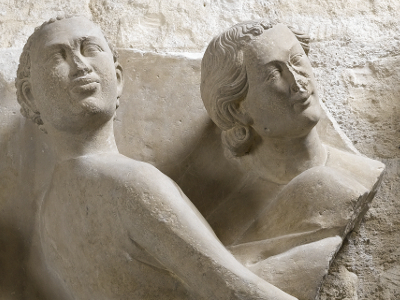
Jacqueline E. Jung is associate professor in the Department of the History of Art at Yale University. Her new book, published earlier this year, is Eloquent Bodies: Movement, Expression, and the Human Figure in Gothic Sculpture.
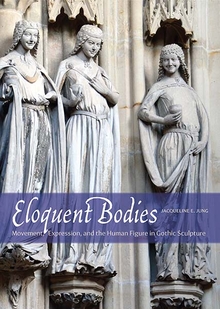
FURTHER READING
Martin Büchsel, “Nur der Tyrann hat sein eigenes Gesicht. Königsbilder im 12. Und 13. Jahrhundert in Frankreich und Deutschland,” in Das Porträt vor der Erfindung des Porträts, ed. Martin Büchsel and Peter Schmidt (Mainz: Philipp von Zabern 2003), 123-40 (for the kings’ heads at Chartres).
Caroline Walker Bynum, The Resurrection of the Body in Western Christianity, 200-1336 (New York: Columbia University Press, 1995).
Gay L. Byron, Symbolic Blackness and Ethnic Difference in Early Christian Literature (London: Routledge, 2002).
Jean Devisse, “The Black and His Color: From Symbols to Realities,” in The Image of the Black in Western Art II: From the Early Christian Era to the “Age of Discovery,” Part 1: From the Demonic Threat to the Incarnation of Sainthood, new ed., ed. David Bindman and Henry Louis Gates, Jr. (orig. 1979; Cambridge, Mass.: Harvard University Press, 2010), 73-138 (“crouching” “menial” figure at Chartres at 121).
Jacqueline de Weever, Sheba’s Daughters: Whitening and Demonizing the Saracen Woman in Medieval French Epic (New York: Routledge, 1998).
Paul H. D. Kaplan, “The Calenberg Altarpiece: Black African Christians in Renaissance Germany,” in Germany and the Black Diaspora: Points of Contact, 1250-1914, ed. Mischa Honeck, Martin Klimke, and Anne Kuhlmann (New York: Berghahn, 2013), 21-37.
Sara Lipton, “Where Are the Gothic Jewish Women? On the Non-Iconography of the Jewess in the Cantigas de Santa Maria.” Jewish History 22, nos. 1-2 (2008): 139-77.
Kirk Savage, Standing Soldiers: Kneeling Slaves: Race, War, and Monument in Nineteenth-Century America, new ed. (Princeton: Princeton University Press, 2018).
Guda Suckale-Redlefsen, Mauritius: Der heilige Mohr – The Black Saint Maurice (Houston: Menil Foundation 1987), 47 (for “the cringing attitude” of the servant at Chartres).























